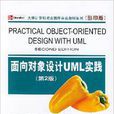《面向對象設計UML實踐(第2版)》是2004年清華大學出版社出版的圖書。
基本介紹
- 書名:面向對象設計UML實踐(第2版)
- ISBN:9787302087847
- 定價:39元
- 出版社:清華大學出版社
- 出版時間:2004-6-28
- 裝幀:平裝
圖書簡介,圖書目錄,
圖書簡介
全書包括14章和3個附錄,分另為UML概述,對象建模,軟體開發過程,餐館預訂系統的業務建模、分析、設計及實現,類和對象圖,互動圖,構件圖,約束,實現策略,原則與模式等。全書語言準確嚴謹,表達規範,簡潔明了,很適合作為面向對象設計的英語授課教材。
本書自第一版出版以來,深受讀者喜愛。為了適應面向對象設計發展,第2版在保留第1版特點的同時,根據當前軟體工程的發展趨勢和教學特點,精心選擇了最主要的基本內容進行介紹。
圖書目錄
1 Introduction to UML 1
Models and modelling 1
Methodologies 5
The Unified Modeling language 7
Design models and code 11
The software development process 12
Summary 12
Exercises 13
2 Modelling with Objects 14
The object model 14
Classes and objects 16
Object properties 19
Avoiding data replication 21
Links 21
Associations 24
Message passing 25
Polymorphism 27
Dynamic binding 32
The applicability of the object model 33
Summary 35
Exercises 36
3 Software Development Processes 39
The waterfall model 39
Alternatives to the waterfall model 43
The Unified Process 46
The role of models in development 47
The use of UML in the Unified Process 49
Summary 51
Exercises 52
4 Restaurant System: Business Modelling 53
Informal requirements 53
Use case modelling 55
Describing use cases 58
Structuring the use case model 61
Completing the use case model 65
Domain Modelling 67
Glossaries 71
Summary 71
Exercises 72
5 Restaurant System: Analysis 75
The purpose of analysis 75
Object design 77
Software Architecture 78
Use case realization 82
Recording new bookings 88
Cancelling bookings 90
Updating bookings 92
Completing The Analysis Model 94
Summary 94
Exercises 96
6 Restaurant System: Design 98
Receiving input from the user 98
Producing output 101
Persistent data storage 104
The Design Model 109
Detailed class design 109
Dynamic modelling of behaviour 111
A statechart for the booking system 113
A statechart for reservations 117
Summary 119
Exercises 119
7 Restaurant System: Implementation 121
Implementation diagrams 121
Implementation strategies 124
Application frameworks 125
The Java AWT framework 128
Implementation of classes 130
Implementation of associations 134
Implementation of operations 137
Summary 139
Exercises 140
8 Class and Object Diagrams 141
Data types 142
Classes 144
Describing objects with classes 145
Associations 150
Generalization and specialization 156
Inheritance of attributes and operations 160
Aggregation 164
Composition 166
Association classes 168
N-ary associations 171
Qualified associations 172
Interfaces 175
Templates 176
Summary 177
Exercises 178
9 Interaction Diagrams 187
Collaborations 187
Classifier roles 189
Association roles 190
Interaction diagrams 192
Object creation 195
Object destruction 196
Role multiplicity and iterated messages 197
Multiobjects 198
Conditional messages 200
Messages to self 203
Summary 204
Exercises 205
10 Statecharts 208
State-dependent behaviour 209
States, events and transitions 210
Initial and final states 211
Guard conditions 212
Actions 214
Activities 216
Composite states 218
History states 221
Summary of the CD player 222
Dynamic modelling in practice 223
Time events 228
Activity states 228
Summary of the ticket machine 229
Summary 229
Exercises 231
11 Component Diagrams 235
Dependencies 236
Components and Artefacts 237
Component Diagrams 239
Some common physical relationships 239
Compilation dependencies 241
Components and Interfaces 245
Summary 246
Exercises 246
12 Constraints 248
Standard constraints 249
The Object Constraint Language 250
The context of a constraint 251
Navigation expressions 253
OCL data types and operations 256
Constraints 260
Stereotyped constraints 263
Constraints and generalization 266
Summary 267
Exercises 268
13 Implementation Strategies 270
CONTENTS ix
Implementing associations 271
Unidirectional implementations 272
Bidirectional implementations 275
Implementing qualified associations 282
Implementing association classes 283
Implementing constraints 285
Implementing statecharts 286
Reverse Engineering 289
Summary 293
Exercises 294
14 Principles and Patterns 298
The open–closed principle 299
No concrete superclasses 303
Decouple the interface hierarchy 305
The Liskov substitution principle 307
Interactions determine structure 308
Design patterns 310
Recursive structures 312
The State and Strategy patterns 316
MVC, document/view and Observer 317
Applying visitor to the stock control program 320
Summary 324
Exercises 324
A UML Notation Summary 326
General concepts 326
Model structure 329
Use case diagrams 330
Object diagrams 330
Collaborations 331
Messages 332
Collaboration diagrams 333
Sequence diagrams 333
Class diagrams 335
Statechart diagrams 338
Component diagrams 339
Templates 340
B OCL Summary 341
Constraints 341
Expressions 341
Basic Types 342
Model Types 344
Collections 344
C A Template for use case descriptions 348

